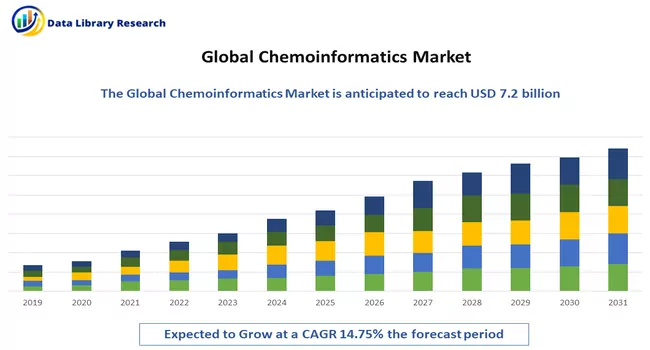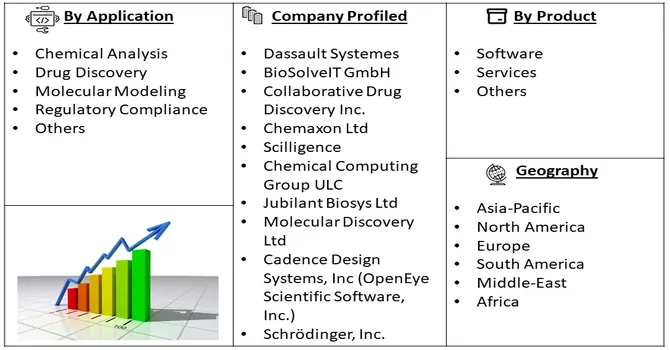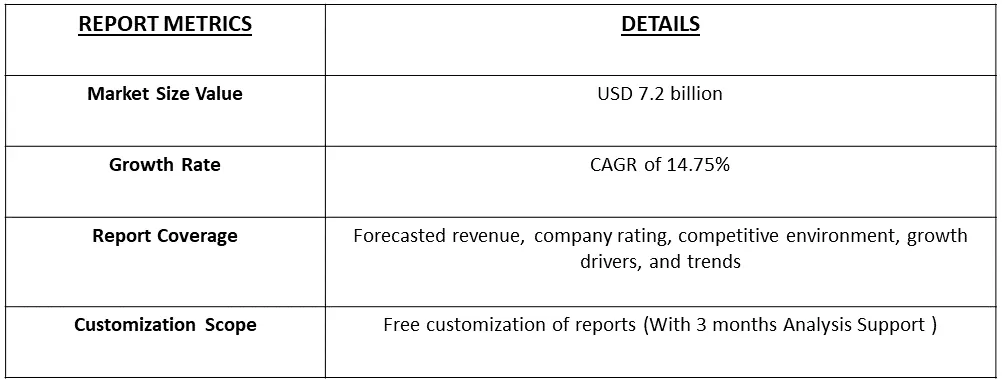The Chemoinformatics Market size is estimated at USD 7.2 billion in 2023 and is expected to reach a CAGR of 14.75% during the forecast period (2024-2031).

Get Complete Analysis Of The Report - Download Free Sample PDF
Chemoinformatics, also known as cheminformatics, is a scientific discipline that involves the application of information and computational techniques to solve problems in the field of chemistry. It integrates methods from computer science, mathematics, and statistics to analyze and interpret chemical data. Chemoinformatics plays a crucial role in the storage, retrieval, analysis, and visualization of chemical information. It encompasses the development and application of computational tools for the study of chemical structures, properties, and activities, aiding in tasks such as drug discovery, chemical database management, and the design of novel chemical compounds. Chemoinformatics methods often involve the representation of chemical structures in digital formats, allowing for the efficient handling and analysis of large datasets. This field is instrumental in leveraging the power of computers to extract meaningful insights from chemical data, contributing to advancements in various areas of chemistry and pharmaceutical research.
The chemoinformatics market is experiencing robust growth driven by multiple key factors. Advances in drug discovery, particularly the integration of computational tools, enhance the identification of potential drug candidates, expediting the research process. The rising significance of big data in chemistry necessitates sophisticated informatics solutions, and chemoinformatics plays a pivotal role in managing and extracting insights from vast datasets. As personalized medicine gains prominence, chemoinformatics becomes crucial in deciphering complex molecular data for tailored therapeutic interventions. Beyond pharmaceuticals, the market extends its applications to material science, contributing to the design and optimization of materials with specific properties. Improved research productivity, driven by streamlined data analysis and interpretation, further fuels the adoption of chemoinformatics tools.
Market Segmentation: The Global Cheminformatics Market is Segmented by Application (Chemical Analysis (Chemical Databases, Chemometrics, Molecular Modelling, and Other Chemical Analysis), Drug Discovery and Validation, Virtual Screening, and Other Applications) and Geography (North America, Europe, Asia-Pacific, Middle East and Africa, and South America). The value is provided in (USD million) for the above segments.

For Detailed Market Segmentation - Download Free Sample PDF
Market Drivers:
Innovations and Advancements in the Drug Development Process:
Innovations and advancements in the drug development process have been profoundly influenced by the integration of chemoinformatics, ushering in a transformative era in pharmaceutical research. The incorporation of computational tools, artificial intelligence, and machine learning in chemoinformatics has revolutionized various stages of drug discovery, expediting processes and enhancing cost-effectiveness. Virtual screening, empowered by chemoinformatics, enables efficient evaluation of vast chemical libraries, while three-dimensional molecular modelling and virtual ligand docking support rational drug design, accelerating the identification of lead compounds. Beyond small molecule drug discovery, chemoinformatics extends its impact to biologics and precision medicine, facilitating the analysis of complex biological data and the development of targeted therapies. Collaborative efforts between pharmaceutical companies, research institutions, and technology providers further drive innovations, addressing challenges in data standardization and interoperability. The seamless integration of chemoinformatics into the drug development landscape underscores its pivotal role in data-driven decision-making, ultimately contributing to the identification of novel therapeutics and the realization of more precise and personalized treatment approaches.
Increased Demand of Personalized Medicine:
The increased demand for personalized medicine has propelled the widespread adoption of chemoinformatics, playing a pivotal role in tailoring medical treatments to individual patients. Chemoinformatics facilitates the analysis of vast datasets, incorporating molecular information from genomics, proteomics, and other omics disciplines. This wealth of data enables the identification of specific biomarkers and the development of targeted therapies designed to address the unique molecular characteristics of patients. The integration of chemoinformatics in personalized medicine extends beyond traditional small molecule drug discovery to encompass biologics and precision medicine. Computational tools aid in the identification of potential drug candidates, predict their interactions with individual patient profiles, and optimize treatment regimens. Pharmacogenomics, a field supported by chemoinformatics, focuses on understanding how an individual's genetic makeup influences their response to drugs, allowing for the customization of drug prescriptions based on genetic factors. The synergy between the increased demand for personalized medicine and the sophisticated tools provided by chemoinformatics underscores its integral role in advancing healthcare practices towards more targeted, efficient, and patient-centric therapeutic interventions.
Market Restraints:
Lack of Skilled Labors
The growth of the chemoinformatics market may face challenges due to a potential constraint in the availability of skilled labor. The specialized nature of chemoinformatics requires a workforce with expertise in computational chemistry, data analytics, and molecular modeling. The shortage of adequately trained professionals in these domains could impede the efficient utilization of chemoinformatics tools and hinder the overall market expansion. The intricate nature of tasks involved, such as predictive modeling and data interpretation, demands a skilled workforce capable of harnessing the full potential of these computational approaches. Addressing the gap in skilled labor through training programs, educational initiatives, and collaborative efforts between academia and industry becomes essential to ensure the sustained growth of the chemoinformatics market and to meet the increasing demand for advanced informatics solutions in fields like drug discovery and material science.
The cheminformatics market experienced a positive impact during the COVID-19 pandemic as the pharmaceutical industry swiftly mobilized efforts to develop therapeutic and preventive drugs in response to the global health crisis. Cheminformatics emerged as a crucial tool within the computational toolbox, playing a significant role in therapeutic discovery. The urgency of the pandemic prompted active engagement from the computational chemistry and cheminformatics community in COVID-19 research. A report published by the Journal of Cheminformatics in March 2021 highlighted the rapid onset of computational research dedicated to understanding and addressing the challenges posed by the virus. This active involvement indicated substantial growth in the cheminformatics market amid the pandemic. As ongoing research studies related to COVID-19 persist, there is a foreseeable and continued demand for cheminformatics in the years to come.
Segmental Analysis:
Chemometrics Segment is Expected to Witness Significant Growth Over the Forecast Period
Chemometrics involves the application of statistical and mathematical methods to analyze chemical data. It focuses on extracting meaningful information from complex chemical datasets, often obtained through techniques such as spectroscopy, chromatography, and sensor technologies. Chemometric methods are employed to process and interpret data, identify patterns, and extract relevant chemical information. Common applications include quantitative analysis, calibration, and optimization in areas like quality control, environmental monitoring, and process optimization. Chemometrics plays a crucial role in ensuring the accuracy and reliability of chemical measurements. Chemoinformatics, on the other hand, deals with the application of informatics techniques to chemical research. It involves the storage, retrieval, analysis, and visualization of chemical information. Chemoinformatics leverages computational methods, data mining, and machine learning to handle chemical data, especially related to molecular structures and properties. This field is instrumental in drug discovery, helping researchers identify potential drug candidates, predict their properties, and optimize molecular structures for enhanced therapeutic effects. Chemoinformatics also contributes to the management of chemical databases, facilitating efficient storage and retrieval of chemical information. While chemometrics focuses on statistical analysis and modelling of chemical data obtained from experimental techniques, chemoinformatics deals with computational methods for handling chemical information, especially in the context of molecular structures and properties. Both fields play crucial roles in advancing chemical research, offering complementary approaches to enhance the understanding and application of chemical data in various scientific and industrial domains.
North America Region is Expected to Witness Significant Growth Over the Forecast Period
Anticipated to claim a substantial market share during the forecast period, North America is poised for significant growth in the chemoinformatics sector, propelled by increased investment in the biotechnology domain. The region's commitment to advancing drug discovery, coupled with the frequent approval and launch of diverse platforms, contributes to its prominence. Notably, Dotmatics' introduction of its small molecule drug discovery solution in the United States in July 2022 underscores the region's focus on innovation. This integrated R&D platform, equipped with pre-configured workflows and enhanced data management capabilities, fosters collaboration, streamlines research team productivity, and expedites the transition from data insights to decisions, thereby augmenting market prospects. Additionally, collaborations and acquisitions among key players in North America, such as Chemical Computing Group's acquisition of Discngine SAS in December 2022, demonstrate the region's concerted efforts to overcome cheminformatics challenges. By integrating Discngine's scientific expertise with CCG's leadership in molecular modeling software, these collaborations are expected to accelerate the development of life sciences solutions, further contributing to market growth.

Get Complete Analysis Of The Report - Download Free Sample PDF
The field of chemoinformatics has experienced notable traction, particularly within research institutions, pharmaceutical companies, the biotechnology sector, research laboratories, and academic institutions. This market has garnered substantial attention and engagement from various stakeholders. Despite its growth, the chemoinformatics market maintains a moderate level of competitiveness, characterized by the participation of a limited number of key market players. The dynamics within this sector reflect the increasing recognition of the importance of chemoinformatics in enhancing research processes, drug discovery endeavors, and data analysis in scientific and academic settings. The market's appeal is evident in its widespread adoption across diverse domains, showcasing its relevance and impact on advancing scientific and pharmaceutical research. Some of the key market players are:
Recent Developments:
1) In October 2023, Cadence Molecular Sciences (OpenEye) disclosed that Pfizer Inc. entered into an agreement to extend and broaden its access to Cadence products and programming toolkits designed for advanced molecular design. The computational software provided by Cadence Molecular Sciences, leveraging physics and AI-based modeling along with cheminformatics, plays a crucial role in facilitating early-stage drug discovery innovation.
2) In June 2023, Vox Biomedical revealed the receipt of a program from the National Institute of General Medical Sciences (NIGMS) aimed at developing an artificial intelligence-based chemical identification library. This library is intended for the identification of volatile organic compounds (VOCs) through the utilization of the gas chromatography and differential mobility spectrometry (GC-DMS) technique.
Q1. What was the Chemoinformatics Market size in 2023?
The Chemoinformatics Market size is estimated at USD 7.2 billion in 2023.
Q2. At what CAGR is the Chemoinformatics market projected to grow within the forecast period?
Chemoinformatics market is expected to reach a CAGR of 14.75% during the forecast period.
Q3. What are the factors driving the Chemoinformatics market?
Key factors that are driving the growth include the Innovations and Advancements in the Drug Development Process and Increased Demand of Personalized Medicine.
Q4. Who are the key players in Chemoinformatics Market?
Some key players operating in the market include
Data Library Research are conducted by industry experts who offer insight on industry structure, market segmentations technology assessment and competitive landscape (CL), and penetration, as well as on emerging trends. Their analysis is based on primary interviews (~ 80%) and secondary research (~ 20%) as well as years of professional expertise in their respective industries. Adding to this, by analysing historical trends and current market positions, our analysts predict where the market will be headed for the next five years. Furthermore, the varying trends of segment & categories geographically presented are also studied and the estimated based on the primary & secondary research.
In this particular report from the supply side Data Library Research has conducted primary surveys (interviews) with the key level executives (VP, CEO’s, Marketing Director, Business Development Manager and SOFT) of the companies that active & prominent as well as the midsized organization
FIGURE 1: DLR RESEARH PROCESS

Extensive primary research was conducted to gain a deeper insight of the market and industry performance. The analysis is based on both primary and secondary research as well as years of professional expertise in the respective industries.
In addition to analysing current and historical trends, our analysts predict where the market is headed over the next five years.
It varies by segment for these categories geographically presented in the list of market tables. Speaking about this particular report we have conducted primary surveys (interviews) with the key level executives (VP, CEO’s, Marketing Director, Business Development Manager and many more) of the major players active in the market.
Secondary ResearchSecondary research was mainly used to collect and identify information useful for the extensive, technical, market-oriented, and Friend’s study of the Global Extra Neutral Alcohol. It was also used to obtain key information about major players, market classification and segmentation according to the industry trends, geographical markets, and developments related to the market and technology perspectives. For this study, analysts have gathered information from various credible sources, such as annual reports, sec filings, journals, white papers, SOFT presentations, and company web sites.
Market Size EstimationBoth, top-down and bottom-up approaches were used to estimate and validate the size of the Global market and to estimate the size of various other dependent submarkets in the overall Extra Neutral Alcohol. The key players in the market were identified through secondary research and their market contributions in the respective geographies were determined through primary and secondary research.
Forecast Model
